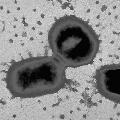



|
| This project is collaborated between The Forsyth Institute (TFI) and The Institute for Genomic Research (TIGR), and is funded by National Institute of Dental and Craniofacial Research (NIDCR) |
|
|
|||||||||||||||||||||||||
Constructing random genomic libraries of P. gingivalis DNAThe primary sequencing library (1.8-2.5 kb inserts) should ideally contain fragments beginning (or ending) in every small interval of the genome, and these fragments should occur with close to equal frequencies in every interval. In addition, the total number of independent clones in the library should be large enough to guarantee that every part of the genome is represented. Plasmid libraries are most likely to fit the random model if made from relatively small inserts in a relatively narrow size range in order to minimize differences in growth rate and in order to minimize rearrangements. A random library is best constructed from mechanically sheared fragments since any kind of enzymatic cleavage is generally non-random. heared DNA fragments are blunt-ended, gel fractionated and inserts of average size 1.8-2.5 kb are cloned into pUC18. The quality of the library for a shotgun approach to sequencing and assembly is assessed by evaluating approximately 500 and then 4000 sequences. The sequences were assembled using the ABI AutoAssembler™ program. The assembly closely fitted an ideal Lander and Waterman (1988) model for the assembly of a ~2.0 Mb genome generated from shotgun sequencing fragments. The number of gaps determined from this analysis should correpond to the values predicted by the Lander-Waterman model. If the data indicate that a library represents a random representation of the genome, large-scale sequencing will proceed. If there are any indications that there are problems in library construction, a new library is made and analyzed. Additional checks for randomness are performed as the project progresses. Lambda DashII will be used for construction of the 18 kb insert plasmid library. The advantage of a lytic phage is that genes whose expression may be deleterious in plasmid vectors (and thus not appear in such libraries) can be cloned in the lytic lambda. |
||||
|
This page is created and maintained by Drs. Margaret Duncan, Floyd Dewhirst, and Tsute Chen, Department of Molecular Genetics, The Forsyth Institute . Last modified on 02/20/2002 Copyright 2000, 2001, 2002 by The Forsyth Institute |